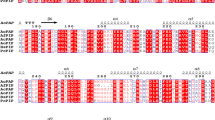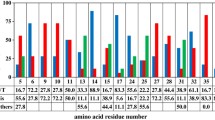Abstract
This article focuses on designing mutations of the PA-IIL lectin from Pseudomonas aeruginosa that lead to change in specificity. Following the previous results revealing the importance of the amino acid triad 22–23–24 (so-called specificity-binding loop), saturation in silico mutagenesis was performed, with the intent of finding mutations that increase the lectin’s affinity and modify its specificity. For that purpose, a combination of docking, molecular dynamics and binding free energy calculation was used. The combination of methods revealed mutations that changed the performance of the wild-type lectin and its mutants to their preferred partners. The mutation at position 22 resulted in 85 % in inactivation of the binding site, and the mutation at 23 did not have strong effects thanks to the side chain being pointed away from the binding site. Molecular dynamics simulations followed by binding free energy calculation were performed on mutants with promising results from docking, and also at those where the amino acid at position 24 was replaced for bulkier or longer polar chain. The key mutants were also prepared in vitro and their binding properties determined by isothermal titration calorimetry. Combination of the used methods proved to be able to predict changes in the lectin performance and helped in explaining the data observed experimentally.




Similar content being viewed by others
References
Lis H, Sharon N (1998) Lectins: carbohydrate-specific proteins that mediate cellular recognition. Chem Rev 98(2):637–674
Gabius HJ, Andre S, Kaltner H, Siebert HC (2002) The sugar code: functional lectinomics. Biochim Biophys Acta Gen Subj 1572(2–3):165–177
Rini JM (1995) Lectin structure. Ann Rev Biophys Biomol Struct 24:551–577
Cambi A, Koopman M, Figdor CG (2005) How C-type lectins detect pathogens. Cell Microbiol 7(4):481–488
Drickamer K, Fadden AJ (2002) Genomic analysis of C-type lectins. Glycogenomics Impact Genomics Inform Glycobiol 69:59–72
Drickamer K, Taylor ME (1993) Biology of animal lectins. Ann Rev Cell Biol 9:237–264
Drickamer K (1996) Ca2+-dependent sugar recognition by animal lectins. Biochem Soc Trans 24(1):146–150
Gilboa-Garber N (1982) Pseudomonas aeruginosa lectins. Methods Enzymol 83:378–385
Rhim AD, Stoykova LI, Trindade AJ, Glick MC, Scanlin TF (2004) Altered terminal glycosylation and the pathophysiology of CF lung disease. J Cyst Fibros 3:95–96
Roussel P, Lamblin G (2003) The glycosylation of airway mucins in cystic fibrosis and its relationship with lung infection by Pseudomonas aeruginosa. Adv Exp Med Biol 535:17–32
Tielker D, Hacker S, Loris R, Strathmann M, Wingender J, Wilhelm S, Rosenau F, Jaeger K-E (2005) Pseudomonas aeruginosa lectin LecB is located in the outer membrane and is involved in biofilm formation. Microbiology 151:1313–1323
Sonawane A, Jyot J, Ramphal R (2006) Pseudomonas aeruginosa LecB is involved in pilus biogenesis and protease IV activity but not in adhesion to respiratory mucins. Infect Immun 74(12):7035–7039
Cioci G, Mitchell EP, Gautier C, Wimmerova M, Sudakevitz D, Perez S, Gilboa-Garber N, Imberty A (2003) Structural basis of calcium and galactose recognition by the lectin PA-IL of Pseudomonas aeruginosa. FEBS Lett 555(2):297–301
Mitchell E, Houles C, Sudakevitz D, Wimmerova M, Gautier C, Perez S, Wu AM, Gilboa-Garber N, Imberty A (2002) Structural basis for oligosaccharide-mediated adhesion of Pseudomonas aeruginosa in the lungs of cystic fibrosis patients. Nat Struct Biol 9(12):918–921
Mitchell EP, Sabin C, Snajdrova L, Pokorna M, Perret S, Gautier C, Hofr C, Gilboa-Garber N, Koca J, Wimmerova M, Imberty A (2005) High affinity fucose binding of Pseudomonas aeruginosa lectin PA-IIL: 1.0 angstrom resolution crystal structure of the complex combined with thermodynamics and computational chemistry approaches. Proteins 58(3):735–746
Pokorna M, Cioci G, Perret S, Rebuffet E, Kostlanova N, Adam J, Gilboa-Garber N, Mitchell EP, Imberty A, Wimmerova M (2006) Unusual entropy-driven affinity of Chromobacterium violaceum lectin CV-IIL toward fucose and mannose. Biochemistry 45(24):7501–7510
Sudakevitz D, Kostlanova N, Blatman-Jan G, Mitchell EP, Lerrer B, Wimmerova M, Katcoff DJ, Imberty A, Gilboa-Garber N (2004) A new Ralstonia solanacearum high affinity mannose-binding lectin RS-IIL structurally resembling the Pseudomonas aeruginosa fucose-specific lectin PA-IIL. Mol Microbiol 52:691–700
Adam J, Pokorna M, Sabin C, Mitchell EP, Imberty A, Wimmerova M (2007) Engineering of PA-IIL lectin from Pseudomonas aeruginosa—unravelling the role of the specificity loop for sugar preference. BMC Struct Biol 7:36
Sabin C, Mitchell EP, Pokorna M, Gautier C, Utille JP, Wimmerova M, Imberty A (2006) Binding of different monosaccharides by lectin PA-IIL from Pseudomonas aeruginosa: thermodynamics data correlated with X-ray structures. FEBS Lett 580(3):982–987
Adam J, Kriz Z, Prokop M, Wimmerova M, Koca J (2008) In silico mutagenesis and docking studies of Pseudomonas aeruginosa PA-IIL lectin—predicting binding modes and energies. J Chem Inf Model 48(11):2234–2242
Sali A, Blundell TL (1993) Comparative protein modeling by satisfaction of spatial restraints. J Mol Biol 234(3):779–815
Nurisso A, Kozmon S, Imberty A (2008) Comparison of docking methods for carbohydrate binding in calcium-dependent lectins and prediction of the carbohydrate binding mode to sea cucumber lectin CEL-III. Mol Simul 34(4):469–479
Moura-Tamames S, Ramos MJ, Fernades PA (2009) Modelling beta-1,3-exoglucanase–saccharide interactions: structure of the enzyme-substrate complex and enzyme binding to the cell wall. FEBS J 276:156–157
Agostino M, Jene C, Boyle T, Ramsland PA, Yuriev E (2009) Molecular docking of carbohydrate ligands to antibodies: structural validation against crystal structures. J Chem Inf Model 49(12):2749–2760
Agostino M, Sandrin MS, Thompson PE, Yuriev E, Ramsland PA (2009) In silico analysis of antibody-carbohydrate interactions and its application to xenoreactive antibodies. Mol Immunol 47(2–3):233–246
Mishra SK, Adam J, Wimmerova M, Koca J (2012) In silico mutagenesis and docking study of Ralstonia solanacearum RSL lectin: performance of docking software to predict saccharide binding. J Chem Inf Model 52(5):1250–1261
Yuriev E, Agostino M, Ramsland PA (2011) Challenges and advances in computational docking: 2009 in review. J Mol Recognit 24(2):149–164
Gauto DF, Petruk AA, Modenutti CP, Blanco JI, Di Lella S, Marti MA (2013) Solvent structure improves docking prediction in lectin–carbohydrate complexes. Glycobiology 23(2):241–258. doi:10.1093/glycob/cws147
Morris GM, Goodsell DS, Halliday RS, Huey R, Hart WE, Belew RK, Olson AJ (1998) Automated docking using a Lamarckian genetic algorithm and an empirical binding free energy function. J Comp Chem 19(14):1639–1662
Woods RJ, Woods Group (2005–2014) Biomolecule builder, GLYCAM Web. Complex Carbohydrate Research Center, University of Georgia. http://www.glycam.com
Vriend G (1990) What if—a molecular modeling and drug design program. J Mol Graph 8(1):52–56
Frisch MJ, Trucks GW, Schlegel HB, Scuseria GER, M. A.; Cheeseman JR, Montgomery Jr JA, Vreven T, Kudin KN, Burant JC, Millam JM, Iyengar SS, Tomasi J, Barone V, Mennucci B, Cossi M, Scalmani G, Rega N, Petersson GA, Nakatsuji H, Hada M, Ehara M, Toyota K, Fukuda R, Hasegawa J, Ishida M, Nakajima T, Honda Y, Kitao O, Nakai H, Klene M, Li X, Knox JE, Hratchian HP, Cross JB, Bakken V, Adamo C, Jaramillo J, Gomperts R, Stratmann RE, Yazyev O, Austin AJ, Cammi R, Pomelli C, Ochterski JW, Ayala PY, Morokuma K, Voth GA, Salvador P, Dannenberg JJ, Zakrzewski VG, Dapprich S, Daniels AD, Strain MC, Farkas O, Malick DK, Rabuck AD, Raghavachari K, Foresman JB, Ortiz JV, Cui Q, Baboul AG, Clifford S, Cioslowski J, Stefanov BB, Liu G, Liashenko A, Piskorz P, Komaromi I, Martin RL, Fox DJ, Keith T, Al-Laham MA, Peng CY, Nanayakkara A, Challacombe M, Gill PMW, Johnson B, Chen W, Wong MW, Gonzalez C, Pople JA (2004) Gaussian 03, Revision C.02. Gaussian, Inc. Wallingford
Case DA, Cheatham TE, Darden T, Gohlke H, Luo R, Merz KM, Onufriev A, Simmerling C, Wang B, Woods RJ (2005) The Amber biomolecular simulation programs. J Comp Chem 26(16):1668–1688
Pearlman DA, Case DA, Caldwell JW, Ross WS, Cheatham TE, Debolt S, Ferguson D, Seibel G, Kollman P (1995) Amber, a package of computer-programs for applying molecular mechanics, normal-mode analysis, molecular-dynamics and free-energy calculations to simulate the structural and energetic properties of molecules. Comp Phys Commun 91(1–3):1–41
Weiner SJ, Kollman PA, Case DA, Singh UC, Ghio C, Alagona G, Profeta S, Weiner P (1984) A new force-field for molecular mechanical simulation of nucleic-acids and proteins. J Am Chem Soc 106(3):765–784
Duan Y, Wu C, Chowdhury S, Lee MC, Xiong G, Zhang W, Yang R, Cieplak P, Luo R, Lee T, Caldwell J, Wang J, Kollman P (2003) A point-charge force field for molecular mechanics simulations of proteins based on condensed-phase quantum mechanical calculations. J Comput Chem 24(16):1999–2012
Ryckaert JP, Ciccotti G, Berendsen HJC (1977) Numerical-integration of cartesian equations of motion of a system with constraints—molecular-dynamics of N-alkanes. J Comput Phys 23(3):327–341
Berendsen HJC, Postma JPM, Vangunsteren WF, Dinola A, Haak JR (1984) Molecular-dynamics with coupling to an external bath. J Chem Phys 81(8):3684–3690
Onufriev A, Case DA, Bashford D (2002) Effective born radii in the generalized born approximation: the importance of being perfect. J Comp Chem 23(14):1297–1304
Lazaridis T (2000) Solvent reorganization energy and entropy in hydrophobic hydration. J Phys Chem B 104(20):4964–4979
Di Lella S, Ma L, Diaz Ricci JC, Rabinovich GA, Asher SA, Alvarez RMS (2009) Critical Role of the solvent environment in galectin-1 binding to the disaccharide lactose. Biochemistry 48(4):786–791
Di Lella S, Petruk AA, de Armino DJA, Alvarez RMS (2010) Specific intermolecular interactions of conserved water molecules with amino acids in the galectin-1 carbohydrate recognition domain. J Mol Struct 978(1–3):220–228
Kadirvelraj R, Foley BL, Dyekjaer JD, Woods RJ (2008) Involvement of water in carbohydrate-protein binding: concanavalin a revisited. J Am Chem Soc 130(50):16933–16942
Pearlstein RA, Sherman W, Abel R (2013) Contributions of water transfer energy to protein-ligand association and dissociation barriers: watermap analysis of a series of p38 MAP kinase inhibitors. Proteins 81(9):1509–1526
Acknowledgments
This work was supported by the Czech Science Foundation (Contract No. 13-25401S), the Ministry of Education, Youth and Sports of the Czech Republic (Contract No. LH13055), The European Community’s Seventh Framework Programme under European Regional Development Fund (Contract No. CZ.1.05/1.1.00/02.0068) and under the “Capacities” specific programme (Contract No. 286154—SYLICA). The access to MetaCentrum supercomputing facilities provided under the research intent LM2010005 is highly appreciated.
Author information
Authors and Affiliations
Corresponding authors
Additional information
Zdeněk Kříž, Jan Adam and Jana Mrázková have equally contributed to this work.
Rights and permissions
About this article
Cite this article
Kříž, Z., Adam, J., Mrázková, J. et al. Engineering the Pseudomonas aeruginosa II lectin: designing mutants with changed affinity and specificity. J Comput Aided Mol Des 28, 951–960 (2014). https://doi.org/10.1007/s10822-014-9774-7
Received:
Accepted:
Published:
Issue Date:
DOI: https://doi.org/10.1007/s10822-014-9774-7




